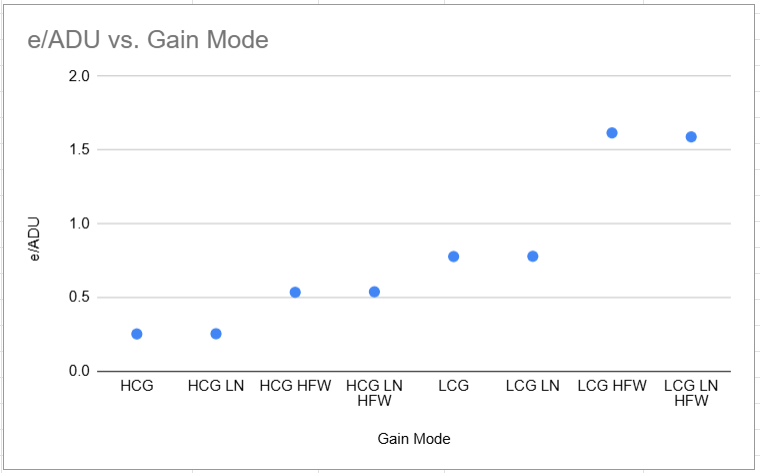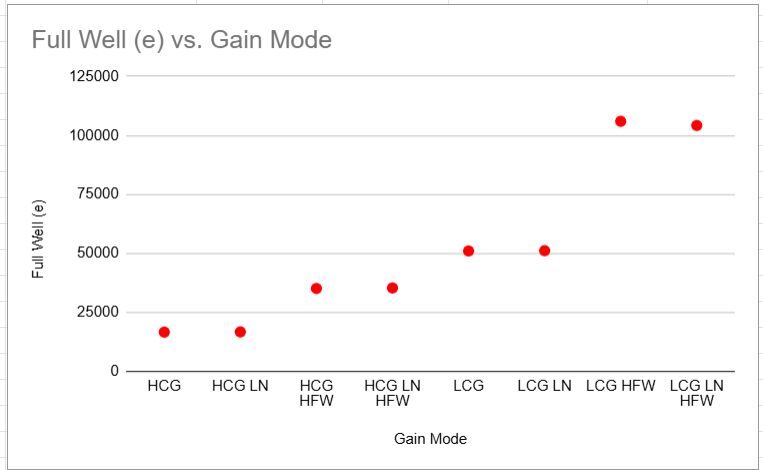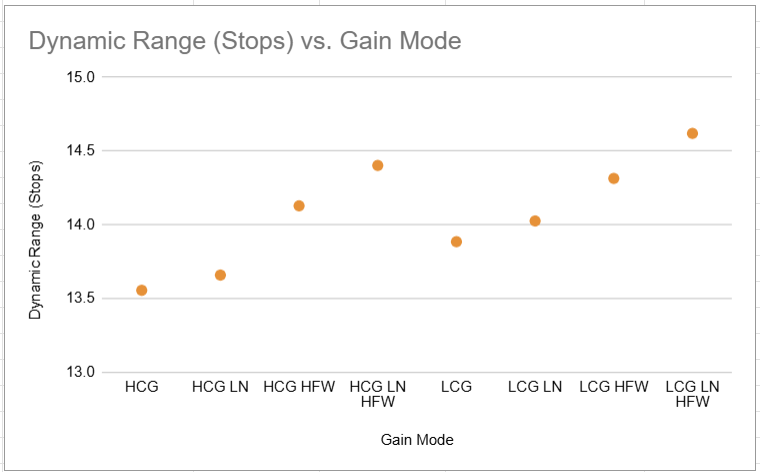Hi, I wanted to share with this forum the sensor analysis I have done on my Touptek ATR2600 mono. My main goal was to see how the 2 options Low Noise ( I will call it LN) and the High Full Well (I will call it HFL) impact the two gain modes HCG and LCG. Based on the results I would love to hear any recommendation on what combination are best to use for my setup and bortle 4-5 sky.area and for the 2 scenarios : brandband and narrowband targets. Mount: AZ-EQ6R Scopes: Esprit150 and TS-Photoline 80 f/6 (with 0.8 reducer Note: - For all testing I have used the Touptek ASCOM driver and not the native driver. Reason is because I will be using Voyager which doesn't have the option to use the native driver
- Temp sensor: -10 C
- The graph below are all at gain 100 (any higher will just worsening in general the values or their combination so the assumption is that for any mode combination the camera will be used at gain 100)
- If of any help, I can share full data for each combination (analysis done with Sharpcap PRO)
- I aim to keep my exposure length to approx 5 minutes or so (the mount doesn't stand well little wind gust and sporadic clouds in Denmark are frequent). So I want to stay with mid range length exposure
- With 5 or so minutes exposure I may not care much about read noise and of course my priority is to reduce shot noise (the big guy!) but without going to a very long exposure for reasons above mentioned
My conclusions are below but please feel free to share thoughts and any other recommendations. Also I know that there is no perfect rule (moon may affect as well as guide performance, etc..) but I am looking to a reasonable "rule of thumb" without getting deep into equations or large dissertations. I know that the discussion can get quite complicated so let's try to keep it simple  I have also verified that with those options and 5 mins exposure I don't get satured stars (and actually i could go longer than 5 mins...). When shotting I use Offset 200 (verified with NINA to be the right value to not get black pixel) Broadband target:- exp 5 min each filter (R/G/B)
- LCG
- Low Noise
Narrowband target:- exp 5 min each filter (Ha/OIII/SII)
- HCG
- Low Noise and High Full Well
Wondering if for Broaddband I should use same options as for Narrowband (for sure if in the same night I shoot RGB and some Ha regions). Thank you Seba     |
You cannot like this item. Reason: "ANONYMOUS".
You cannot remove your like from this item.
Editing a post is only allowed within 24 hours after creating it.
You cannot Like this post because the topic is closed.
Copy the URL below to share a direct link to this post.
This post cannot be edited using the classic forums editor.
To edit this post, please enable the "New forums experience" in your settings.
Note: I have posted the same topic in Cloudynights with the hope to get some feedback there. So if anyone is still interested to follow the topic feel free to check this link https://www.cloudynights.com/topic/948266-full-sensor-analysis-touptek-atr2600-mono-imx571-all-possible-gain-mode-options-hcglcglow-noisehigh-full-well/?p=13862142 |
You cannot like this item. Reason: "ANONYMOUS".
You cannot remove your like from this item.
Editing a post is only allowed within 24 hours after creating it.
You cannot Like this post because the topic is closed.
Copy the URL below to share a direct link to this post.
This post cannot be edited using the classic forums editor.
To edit this post, please enable the "New forums experience" in your settings.
That is a very interesting post. I have the same camera since a few weeks and I am in the process of making the first images. Following for now but I will get back to this post as soon as I have more time.
|
You cannot like this item. Reason: "ANONYMOUS".
You cannot remove your like from this item.
Editing a post is only allowed within 24 hours after creating it.
You cannot Like this post because the topic is closed.
Copy the URL below to share a direct link to this post.
This post cannot be edited using the classic forums editor.
To edit this post, please enable the "New forums experience" in your settings.
You are using a CMOS camera, not a CCD. There is simply no reason for long integration times with CMOS.
|
You cannot like this item. Reason: "ANONYMOUS".
You cannot remove your like from this item.
Editing a post is only allowed within 24 hours after creating it.
You cannot Like this post because the topic is closed.
Copy the URL below to share a direct link to this post.
This post cannot be edited using the classic forums editor.
To edit this post, please enable the "New forums experience" in your settings.
Tony Gondola:
You are using a CMOS camera, not a CCD. There is simply no reason for long integration times with CMOS. As far as I know, the IMX571 only comes in CMOS.
|
You cannot like this item. Reason: "ANONYMOUS".
You cannot remove your like from this item.
Editing a post is only allowed within 24 hours after creating it.
You cannot Like this post because the topic is closed.
Copy the URL below to share a direct link to this post.
This post cannot be edited using the classic forums editor.
To edit this post, please enable the "New forums experience" in your settings.
Of course, it's a CMOS sensor. My point is that the rules for CMOS are different from the old CCD sensors.
|
You cannot like this item. Reason: "ANONYMOUS".
You cannot remove your like from this item.
Editing a post is only allowed within 24 hours after creating it.
You cannot Like this post because the topic is closed.
Copy the URL below to share a direct link to this post.
This post cannot be edited using the classic forums editor.
To edit this post, please enable the "New forums experience" in your settings.
Tony Gondola:
You are using a CMOS camera, not a CCD. There is simply no reason for long integration times with CMOS. *true, however the longer the exposure the lesser the shot noise.
|
You cannot like this item. Reason: "ANONYMOUS".
You cannot remove your like from this item.
Editing a post is only allowed within 24 hours after creating it.
You cannot Like this post because the topic is closed.
Copy the URL below to share a direct link to this post.
This post cannot be edited using the classic forums editor.
To edit this post, please enable the "New forums experience" in your settings.
Of course, it's a CMOS sensor. My point is that the rules for CMOS are different from the old CCD sensors.
I agree, but that wasn't the point of the topic, so why bring it up.
|
You cannot like this item. Reason: "ANONYMOUS".
You cannot remove your like from this item.
Editing a post is only allowed within 24 hours after creating it.
You cannot Like this post because the topic is closed.
Copy the URL below to share a direct link to this post.
This post cannot be edited using the classic forums editor.
To edit this post, please enable the "New forums experience" in your settings.
Yes, but..... You might want to review this: https://www.youtube.com/watch?v=3RH93UvP358Shot noise is addressed at 30:37
|
You cannot like this item. Reason: "ANONYMOUS".
You cannot remove your like from this item.
Editing a post is only allowed within 24 hours after creating it.
You cannot Like this post because the topic is closed.
Copy the URL below to share a direct link to this post.
This post cannot be edited using the classic forums editor.
To edit this post, please enable the "New forums experience" in your settings.
Because, sebaromano is asking for advice and mentioned the length of his subs in the original post.
|
You cannot like this item. Reason: "ANONYMOUS".
You cannot remove your like from this item.
Editing a post is only allowed within 24 hours after creating it.
You cannot Like this post because the topic is closed.
Copy the URL below to share a direct link to this post.
This post cannot be edited using the classic forums editor.
To edit this post, please enable the "New forums experience" in your settings.
Something that was curious about my Risingcam 571 (which I am not 100% sure using the exact same gain schemes as the touptek cameras) was that the high full well mode had an incorrectly reported full well.
The sharpcap sensor analysis was basically the same as what you've presented, and it might lead you to conclude that running the high full well mode makes a lot of sense, but on my camera enabling HFW and Low gain didn't have any pixel values above about 50k ADU. Essentially the e/adu scheme was closer to 1.5 e/ADU (which is why sharpcap thinks the full well is over 100ke) but the linearity went fully horizontal around .75 when looking at pixel values in pixinsight.
I never tested this with HCG and high full well however.
I don't think running HFW and HCG makes sense for narrowband, you'll probably not need that extra dynamic range and the lower read noise can provide benefits if you're exposure time limited.
|
You cannot like this item. Reason: "ANONYMOUS".
You cannot remove your like from this item.
Editing a post is only allowed within 24 hours after creating it.
You cannot Like this post because the topic is closed.
Copy the URL below to share a direct link to this post.
This post cannot be edited using the classic forums editor.
To edit this post, please enable the "New forums experience" in your settings.






